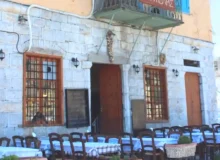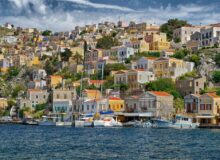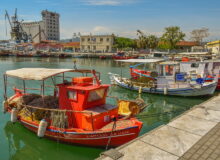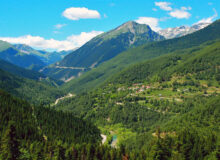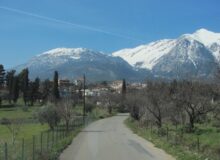The See Greece guide to the island of Leros with a brief history and travel information on how to get there by ferry or by air and what to see and do.

Introduction to Leros
Leros is a charming Greek island in the Dodecanese, located in the southeastern Aegean Sea. It lies between Patmos and Kalymnos, approximately 171 miles (275 km) from Athens. Unlike some of its more tourist-heavy neighbors, Leros retains an authentic Greek character, with a mix of traditional villages, stunning beaches, and a fascinating history shaped by ancient civilizations, medieval knights, and 20th-century conflicts.
This guide covers everything you need to know about Leros, including its history, top sights, activities, the best time to visit, and how to reach the island by air and ferry.
Location of Leros

Leros is situated in the southern part of the Aegean Sea, part of the Dodecanese island group, which lies close to the coast of Turkey. It is positioned between Patmos to the north and Kalymnos to the south, with Lipsi to its northeast. The nearest major island is Kos, about 30 nautical miles to the southeast, while Rhodes, the capital of the Dodecanese, is approximately 100 miles to the southwest.
A Brief History of Leros
Ancient and Medieval Times
Leros has been inhabited since prehistoric times, with evidence of settlements dating back to the Neolithic period. In antiquity, it was associated with the goddess Artemis, and its strategic position made it a target for various powers, including the Persians, Athenians, and Spartans.
During the Byzantine era, Leros was part of the Aegean defense system. In 1309, the Knights of St. John took control, fortifying the island against Ottoman attacks. However, in 1522, the Ottomans conquered Leros along with the rest of the Dodecanese.
Italian Rule and World War II
After the Italo-Turkish War (1911–1912), Italy occupied Leros and the Dodecanese. The Italians heavily fortified the island, building the imposing Lakki town with its distinctive Art Deco architecture. During World War II, Leros became a battleground in the Battle of Leros (1943), when British and Italian forces fought against German troops. The island suffered heavy bombing, and many wartime ruins remain today.
Post-War and Modern Leros
After the war, Leros was briefly under British administration before reuniting with Greece in 1948. In the latter half of the 20th century, the island became known for its psychiatric hospital, which has since been reformed. Today, Leros is a peaceful destination with a growing tourism industry, offering history, natural beauty, and a relaxed atmosphere.

What to See and Do on Leros
1. Explore Leros’ Charming Towns and Villages
– Platanos & Agia Marina: The island’s capital, Platanos, is a picturesque hilltop village connected to the port town of Agia Marina. Wander through narrow streets, visit the Church of Agia Paraskevi, and climb to the Byzantine Castle of Panteli for panoramic views.
– Lakki: Built by the Italians in the 1930s, Lakki features unique Rationalist architecture, including the Town Hall and the old Cine Teatro. The port is also a great spot for waterfront dining.
– Pandeli: A scenic fishing village with a sandy beach and traditional tavernas.
2. Visit Historical Sites
– Castle of Panteli: A medieval fortress offering breathtaking views and a small chapel dedicated to the Panagia Trouloti.
– War Tunnels & Bunkers: Explore the underground tunnels built by the Italians, some of which are open to visitors.
– WWII Shipwrecks: Scuba divers can explore sunken warships from the Battle of Leros.
3. Relax on Leros’ Best Beaches
– Alinda Beach: A long sandy beach with shallow waters, ideal for families.
– Vromolithos Beach: A quiet pebble beach with crystal-clear water.
– Blefoutis Beach: A secluded cove accessible by boat or a short hike.
– Xirokambos Beach: A sandy beach on the southern coast, perfect for a peaceful swim.
4. Enjoy Outdoor Activities
– Hiking: Trails lead to the castle, WWII sites, and scenic viewpoints like Troulos Hill.
– Boat Trips: Take a day trip to nearby islands like Patmos, Lipsi, or Kalymnos.
– Cycling & Scooter Rentals: Explore the island’s quiet roads at your own pace.
5. Taste Local Cuisine
Leros has excellent seafood and traditional Greek dishes. Must-try specialties include:
– Pitaridia (homemade pasta)
– Fresh octopus and grilled fish
– Local cheeses and honey

Best Time to Visit Leros
Leros enjoys a Mediterranean climate, with hot summers and mild winters. The best time to visit depends on your preferences:
– May–June & September–October: Ideal for pleasant weather, fewer crowds, and lower prices.
– July–August: Peak season with warm temperatures (up to 30°C/86°F) and lively nightlife.
– April & November: Quieter, but some businesses may close.
Avoid visiting in winter (December–March) if you want beach activities, as many hotels and restaurants shut down.
How to Get to Leros
By Air
Leros has a small national airport (LRS) with seasonal flights from Athens (45 minutes) operated by Olympic Air and Sky Express. There are no direct international flights, so visitors typically fly to Athens or Kos first.
By Ferry
Ferries are the most common way to reach Leros. Routes include:
– From Piraeus (Athens): 8–10 hours (overnight options available).
– From Kos & Rhodes: 2–4 hours via high-speed catamarans.
– From neighboring islands (Patmos, Kalymnos, Lipsi): 30 mins–2 hours.
Major ferry companies serving Leros include Blue Star Ferries, Dodekanisos Seaways, and Hellenic Seaways.

Getting Around the Island
– Public Buses: Limited but reliable service between main towns.
– Taxis: Available but best booked in advance.
– Car/Scooter Rentals: Recommended for exploring remote beaches and villages.















